A clear personal branding statement is the foundation for defining your value, showcasing your capabilities, and making a strong impression on employers, partners, and clients. The following article will guide you on how to write an effective personal branding statement, complete with practical examples to help you apply it easily and stand out in your career.
Table of Contents
- 1 What is a personal branding statement and why is it important?
- 2 The Golden Structure of an Effective Personal Brand Statement
- 3 Detailed 5-step guide to writing a personal branding statement
- 4 Examples of personal statements by field
- 5 Common mistakes when writing personal branding statements and how to fix them
- 6 Conclude
What is a personal branding statement and why is it important?
A personal branding statement is more than just a few lines about yourself, it’s how you express your value, position yourself, and make a first impression in the minds of others.
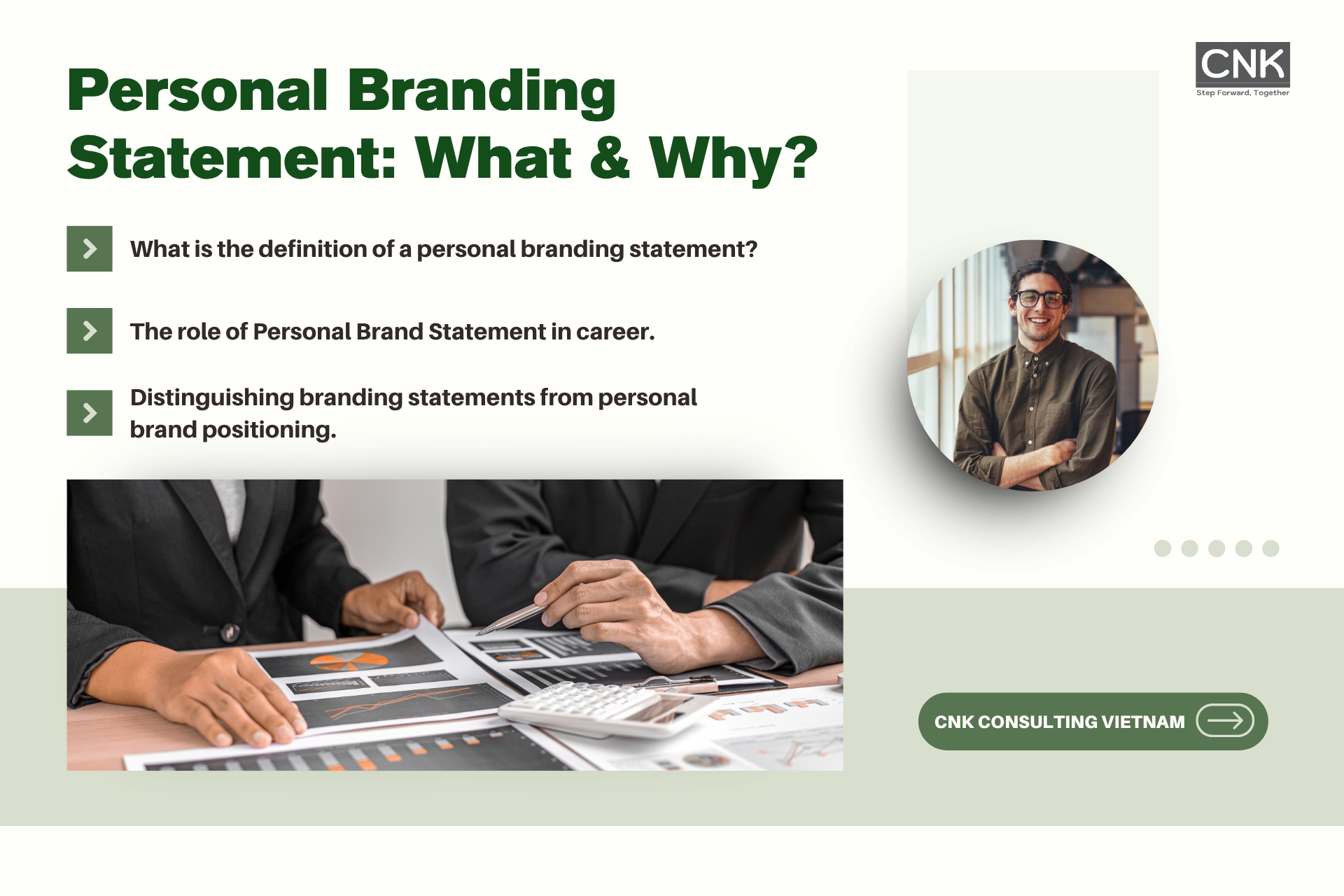
What is the definition of a personal branding statement?
A personal branding statement is a short, concise sentence or paragraph (usually 1-3 sentences long) that summarizes exactly “who are you?, What do you do? and what unique value do you bring to others?”
This is not just an introduction, but a powerful positioning tool, definitively answering the question “Why should I work with you, follow you instead of someone else?”.
In other words, this statement is a polished version of “summary” used to:
- Demonstrate your core skills and expertise.
- Identify the target audience you serve.
- Highlight the benefit or solution you offer.
The role of Personal Brand Statement in career
A personal branding statement is not just a bunch of nice words, but also acts as a strategic foundation to help you orient your career, strengthen your reputation and create the following specific values and benefits:
- Differentiate and be memorable: In a competitive market, a clear statement helps you stand out from the crowd, serving as an “anchor” for people to remember you for a specific expertise.
- Professional Positioning: Personal branding statements help you quickly establish yourself as an expert in your field – an important factor when you’re looking for a job, introducing your services, or wanting to be invited to speak at events.
- Attract the right opportunities: When you clearly communicate your value, you will attract more clients, partners or employers who really need what you do best, avoiding wasting time on opportunities that are not a good fit.
- Build trust and consistency: Your personal branding statement is the guiding principle for all your communications (from LinkedIn, your CV to the way you speak). This consistency builds trust and personal credibility that lasts over time.
Distinguishing branding statements from personal brand positioning
In personal branding strategy, the two concepts Brand Positioning and Brand Statement are often used interchangeably. In fact, they are two inseparable parts but have completely different roles.
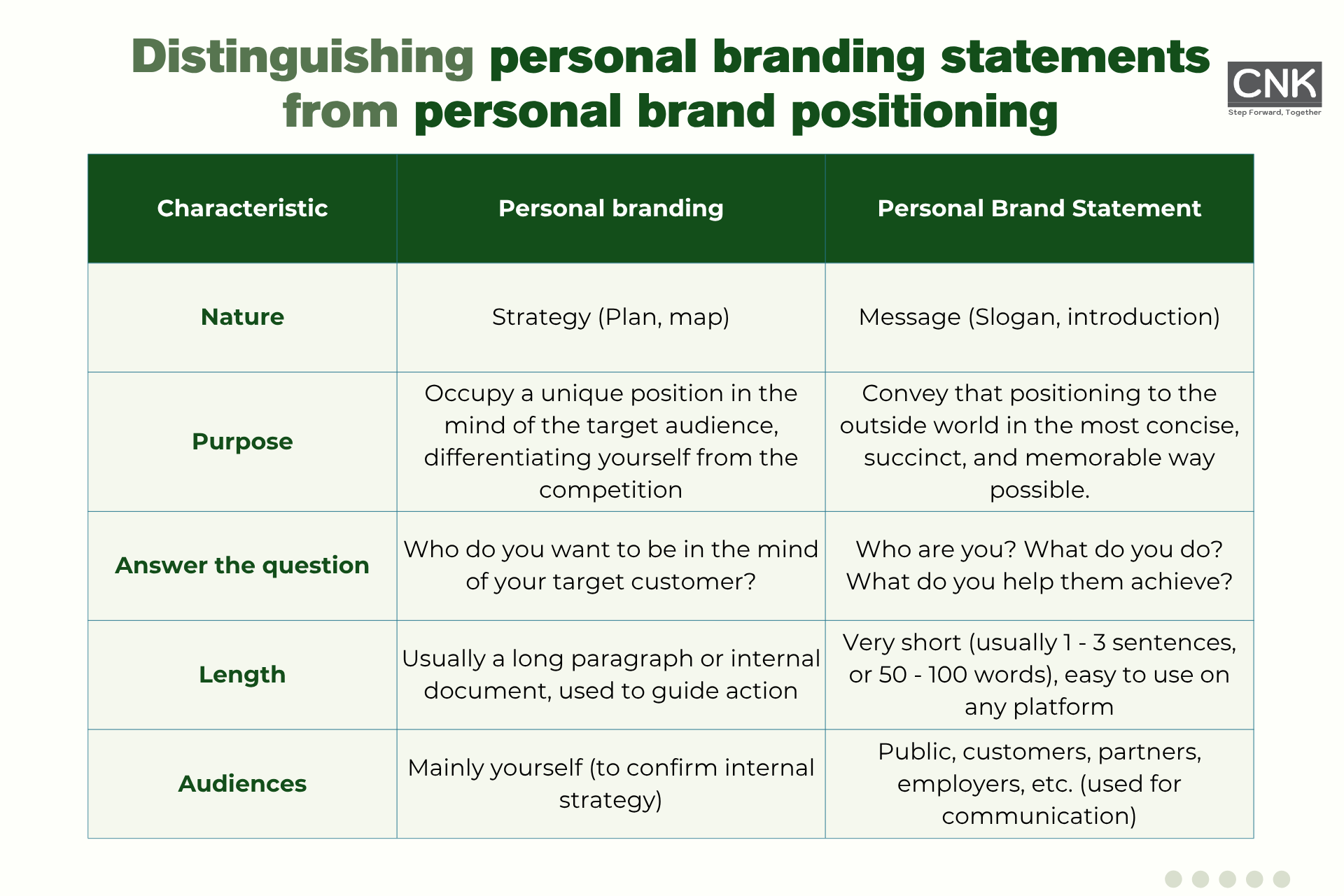
The Golden Structure of an Effective Personal Brand Statement
To create a truly effective personal brand statement, you need to understand the elements that make it up. A solid structure helps you communicate your message clearly and consistently, and makes it easy for others to recognize the value you bring.

Essential elements of a personal branding statement
A successful personal branding statement always revolves around answering the three most important questions of the other person: Who are you? What do you do? and what will I get from you?
Position/Role (Who you are)
This is how you define yourself in your personal branding journey. This role doesn’t have to be an official title at your company, but rather how you want the world to perceive your expertise and core values.
For example, instead of “Content Officer,” use “Brand Storyteller” or “Content Strategist.”
Action/Service (What you do)
This section describes how you use your skills, experience, and expertise to create real value. In other words, “What do you do to help others achieve their goals?”
For example, you might write “Helping CEOs simplify complex technical information” or “By redesigning user experiences in a minimalist way.”
Value/Benefit
Value/benefit is the most important factor that must be specific and attractive to the target audience. Not only show what or how you do, but also the specific results that others receive when working with you.
For example: Instead of writing general things like “helping businesses grow”, “supporting customers to achieve their goals”, you need to clarify the actual results you create such as “…to help them increase their conversion rate from traffic by 30%” or “…helping individuals find their dream career after 90 days”.
The Basic Formula for Creating a Persuasive Statement
The ideal personal brand statement should be as short as an “elevator pitch,” conveying the essence of your value quickly. To make it easier to apply the above three elements, you can use the proven template structures:
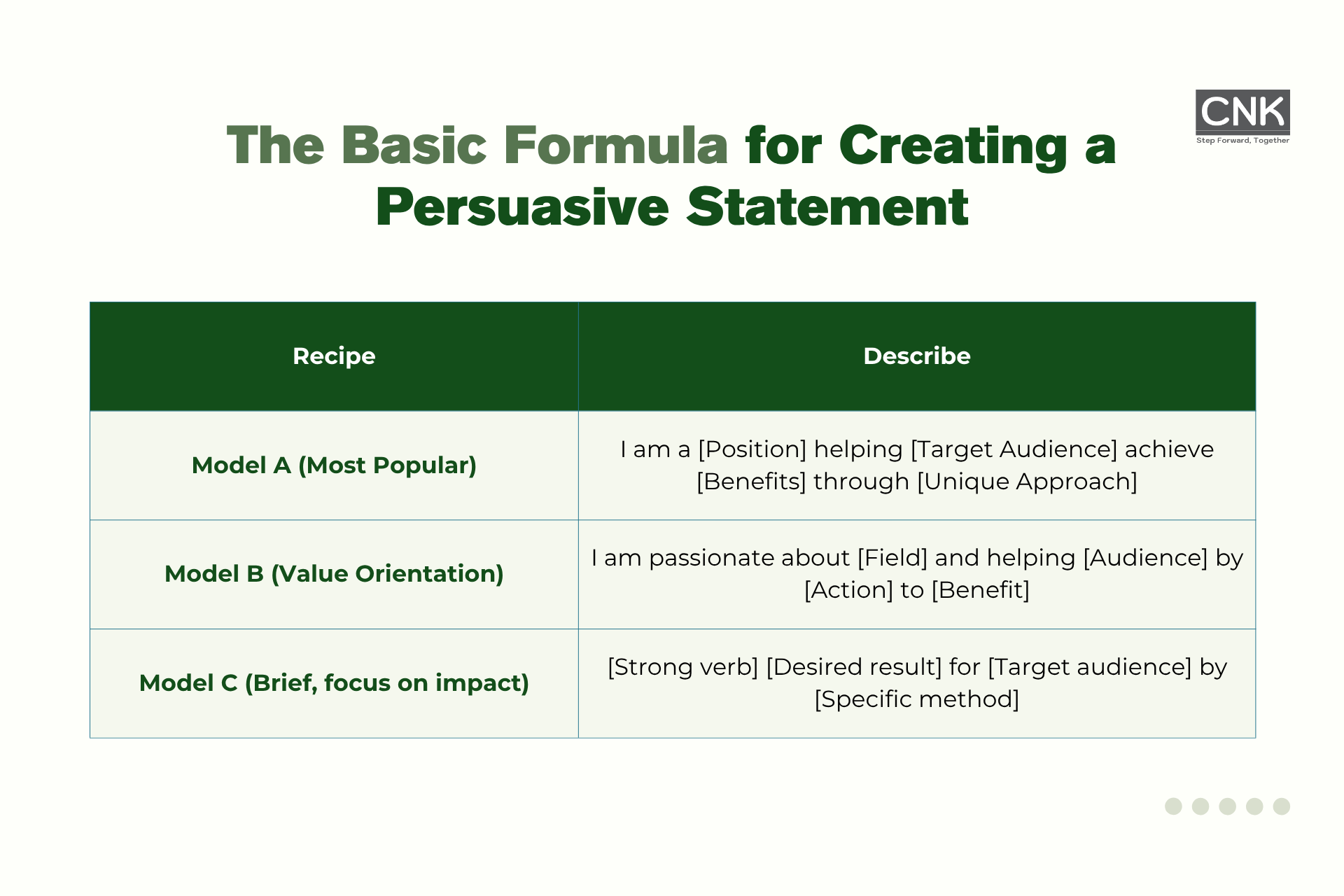
Real life example:
- Model A: I am a Digital Transformation Consultant, helping SMB businesses optimize workflows and reduce operating costs through the application of automated Cloud solutions.
- Model B: I am passionate about sustainability and helping nonprofits by building transparent crowdfunding strategies to expand their social reach.
- Model C: Ensure technology projects are completed on time and within budget for large IT departments by applying the Lean Agile framework.
Note on Length and Language
Once you have the structure and formula, refining the language is the final step to making your statement really shine:
Neat and concise
Your statement should be 2-4 sentences or about 50-100 words. Aim for the reader to grasp the entire message in less than 30 seconds. You need to eliminate unnecessary jargon and technical jargon.
Use strong language (Action Verbs)
- Avoid passive words (like, have). Use action verbs to convey initiative, competence, and results.
- Use words like: Drive, Design, Optimize, Transform, Explore, Simplify. Avoid words like: Have, Help, Ensure
Honest and consistent
- Your statement should reflect who you are and what you are really capable of. Don’t try to create an image that isn’t real.
- Make sure it’s consistent across all platforms: LinkedIn bio, CV introduction, etc. Consistency builds credibility and trust in your personal brand.
Detailed 5-step guide to writing a personal branding statement
Writing a personal brand statement is not a quick task. It is a journey of self-reflection, refinement, discovering your core identity and translating all your values into a short but powerful message. Here is a detailed 5-step process to create the perfect statement:
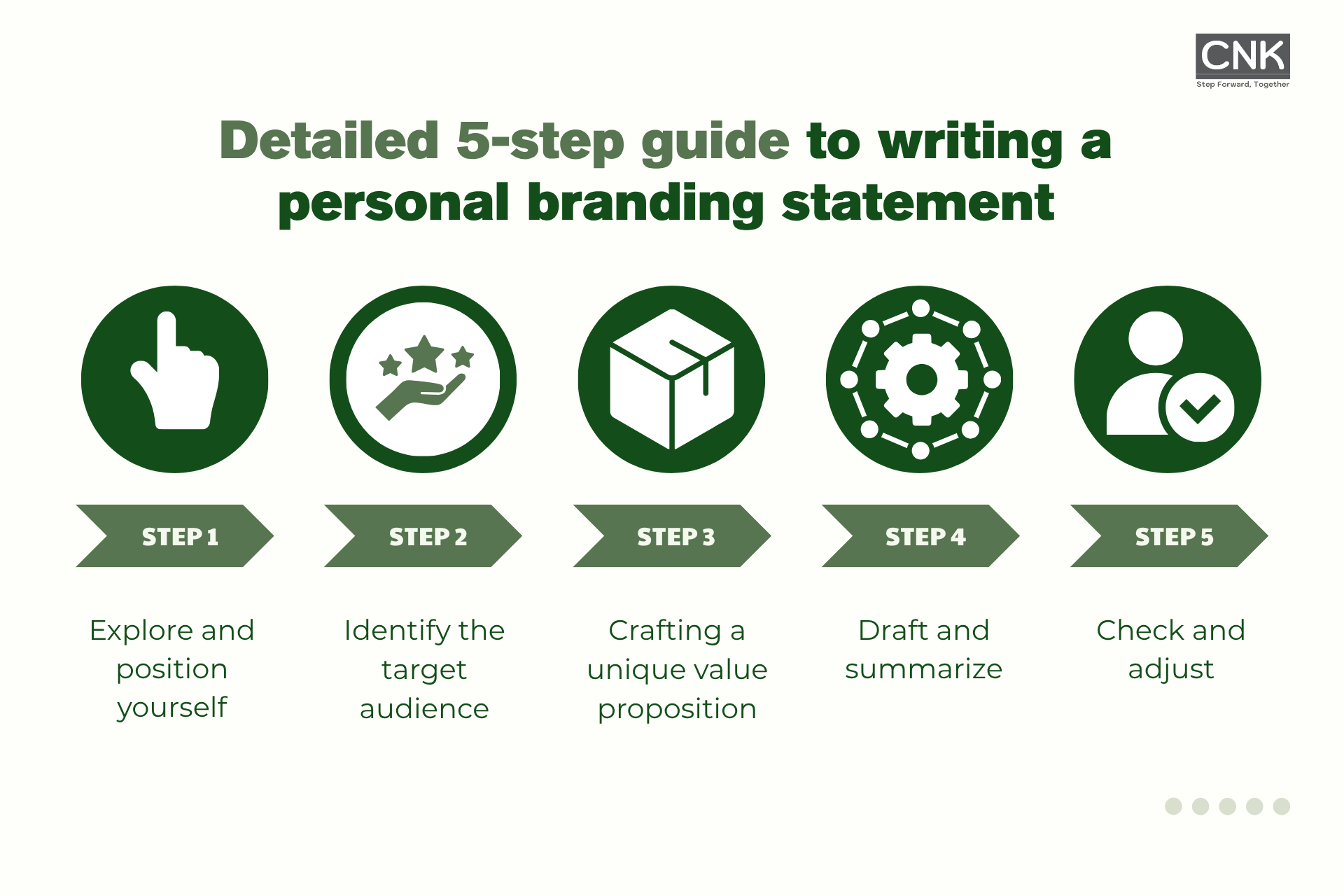
Step 1: Explore and position yourself
Before you start crafting any message, it’s important to first understand yourself. A compelling personal brand statement is always rooted in honesty, reflecting who you are, what your core values are, and how you want to be perceived.
- Identify your strengths: List the skills, expertise, and experiences that you have that set you apart from others.
- Identify your passions: What really excites you? When do you feel most productive and tireless?
- Identify your core values: What principles guide your work and life (e.g., transparency, innovation, efficiency)?
- Finalize your positioning: The intersection of your strengths and passions will create your niche. This is the unique space where you can dominate.
Step 2: Identify the target audience
You can’t appeal to everyone, and a message that tries to please everyone will be meaningless. Identifying who you want to appeal to will help sharpen your message.
- Who are they? (Examples: Tech Startup CEOs, Marketing Graduates, Traditional Business Owners, etc.)
- What do they need? (What is their biggest need/problem?)
- What do they care about most? (What specific results do they expect?)
Step 3: Crafting a unique value proposition
Once you have positioned yourself and identified your target audience, you need to sum them up in a promise. This is what differentiates you from your competitors.
- Make a connection: Use one of the three formulas above, for example, I help [Audience] achieve [Benefit] with [Unique Method].
- Focus on “Why”: Instead of just saying “What are you?” say “Why is your way more effective?”
- Turn features into benefits: For example, your feature is “10 years of programming experience”. Then the benefit you will bring to customers is “building stable and scalable application platforms to minimize long-term maintenance costs”.
Step 4: Draft and summarize
Once you have identified your core elements, start translating them into text. Don’t be afraid to write multiple versions. The first draft doesn’t have to be perfect, and there’s no limit to the length. The first goal is to express every idea as honestly and naturally as possible, then gradually refine and polish it to create a message that is concise, clear, and powerful.
- Write an outline: You can write 3-4 draft versions based on the formula.
- Remove barriers: Cross out vague, general words like effective, good quality, help, etc. Replace them with action verbs and specific results like help improve, optimize 40%, etc.
- Fine-tune your statement: Once you have drafted the following, shorten your statement, removing unnecessary words. Remember that the goal of the statement is clarity and honesty.
Step 5: Check and adjust
Your statement needs to be tested by others to ensure it conveys the message you want it to. Share your statement with a few trusted people like colleagues, mentors, etc. Ask them, “When you hear this statement, what do you think I do and what value do I bring?” If their answers match your intentions, you have a successful statement.
You need to be consistent and update your statement across all your personal communication channels (LinkedIn, Facebook, Website, Blog, Youtube, etc.). And you must always be ready to adjust as your career or positioning changes.
Examples of personal statements by field
Implementing the personal branding statement formula can be challenging. Here are some examples to help you easily implement your personal branding statement:
Personal Statement Example for Job Seekers/Career Changers
For job seekers/career changers, personal branding statements should focus on potential, quick learning ability and passion to compensate for gaps in practical experience:
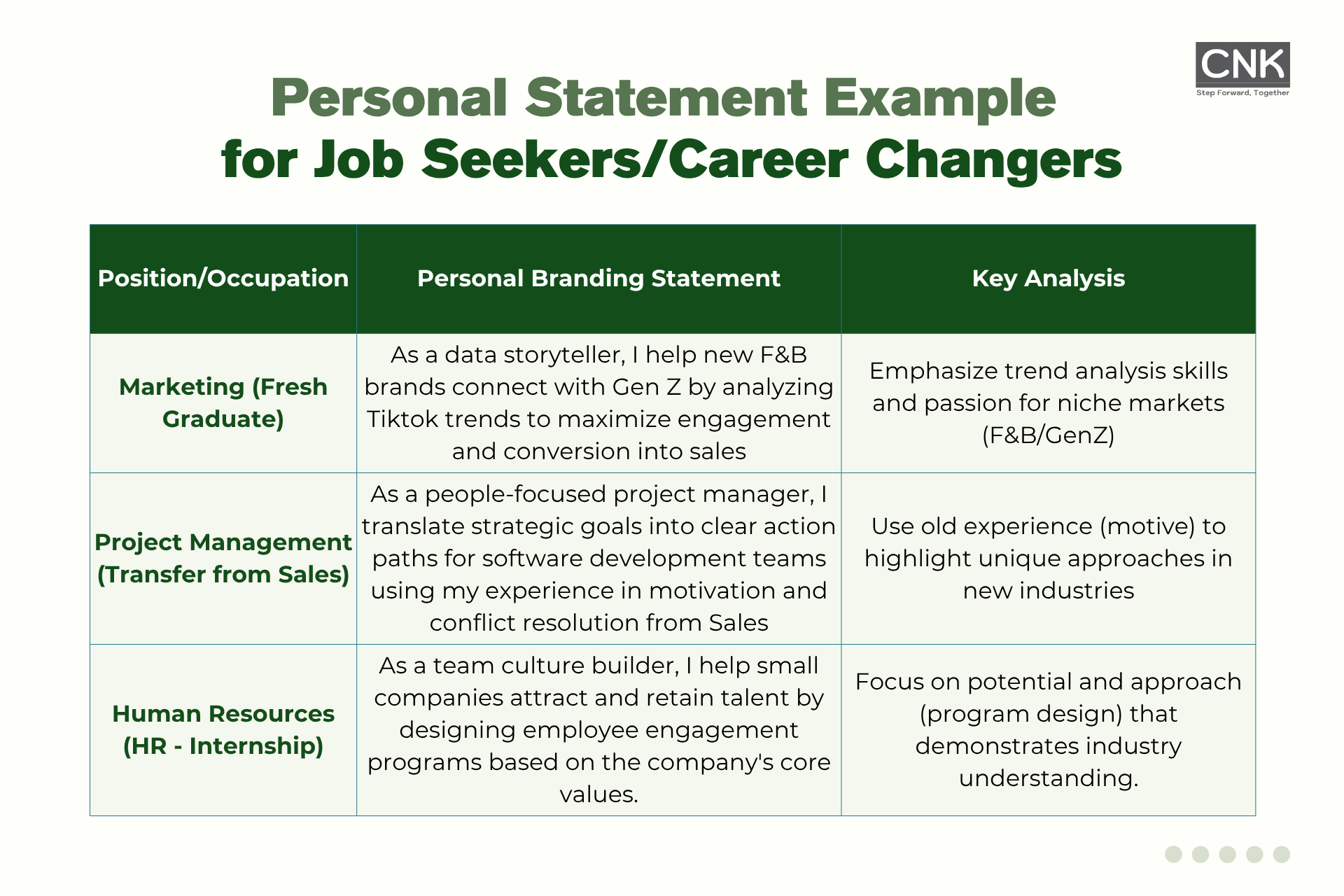
Personal Statement Example for Freelancers
For freelancers, it’s important to be transparent about results and ideal clients to attract the right type of projects.
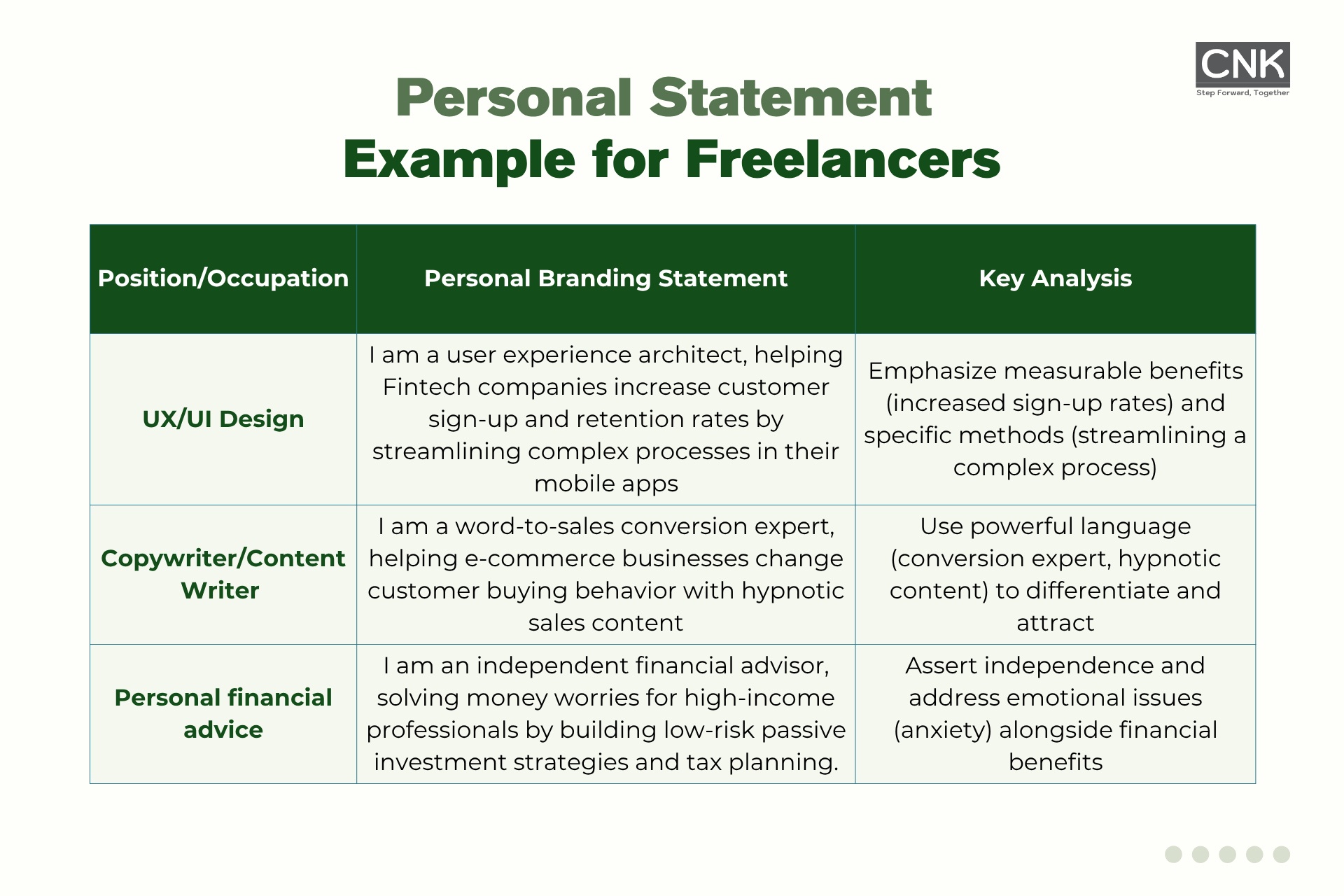
Example of a personal statement for a leader/influencer
Personal statements of leaders/influencers reflect their vision, mission, and the larger impact they bring to the industry or community.
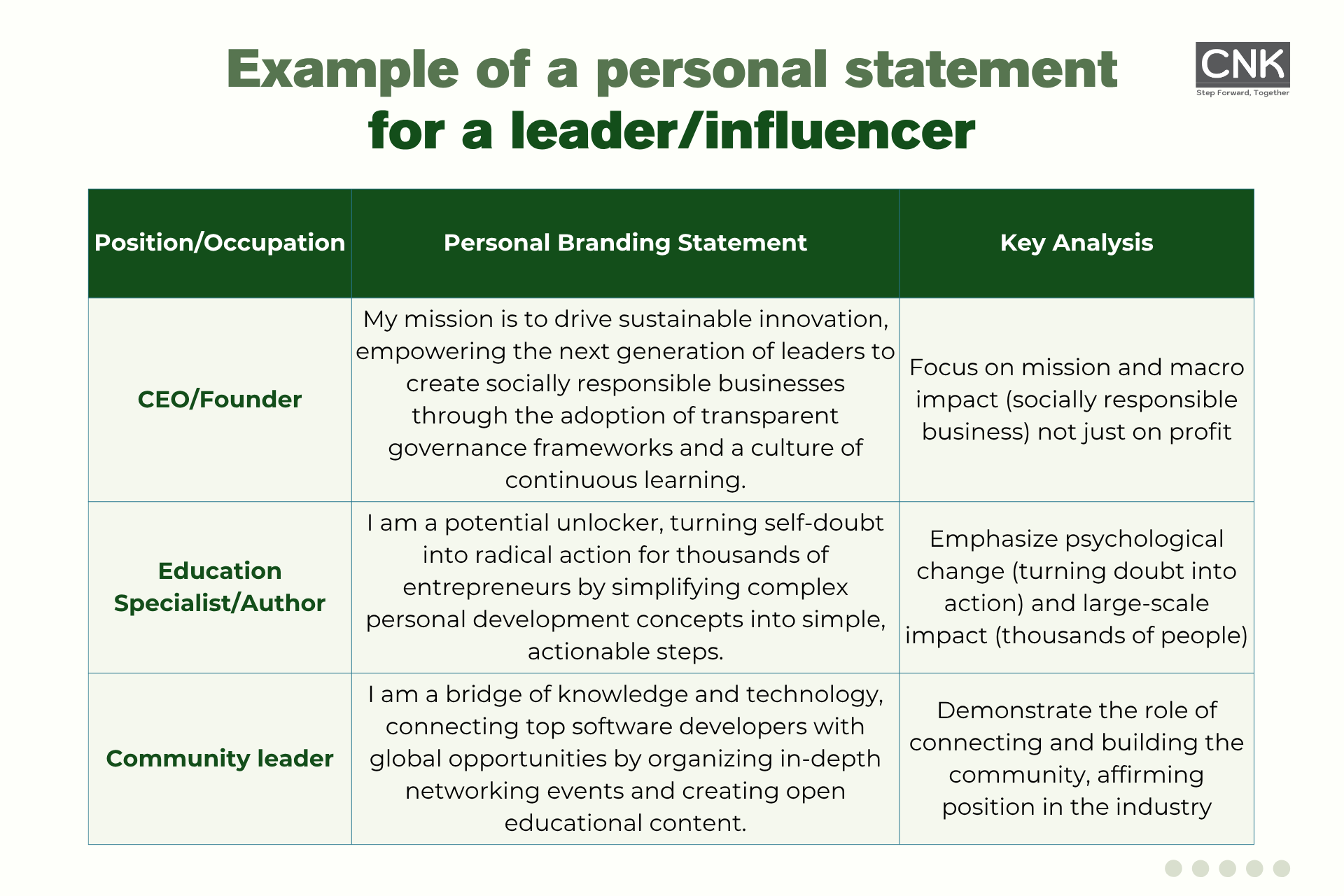
>> Learn More: 10 Powerful Personal Branding Examples to Inspire You
Common mistakes when writing personal branding statements and how to fix them
Many people still make basic mistakes that make their personal branding statements lose their sharpness and persuasiveness. Here are the 3 most common mistakes and detailed instructions on how to fix them:
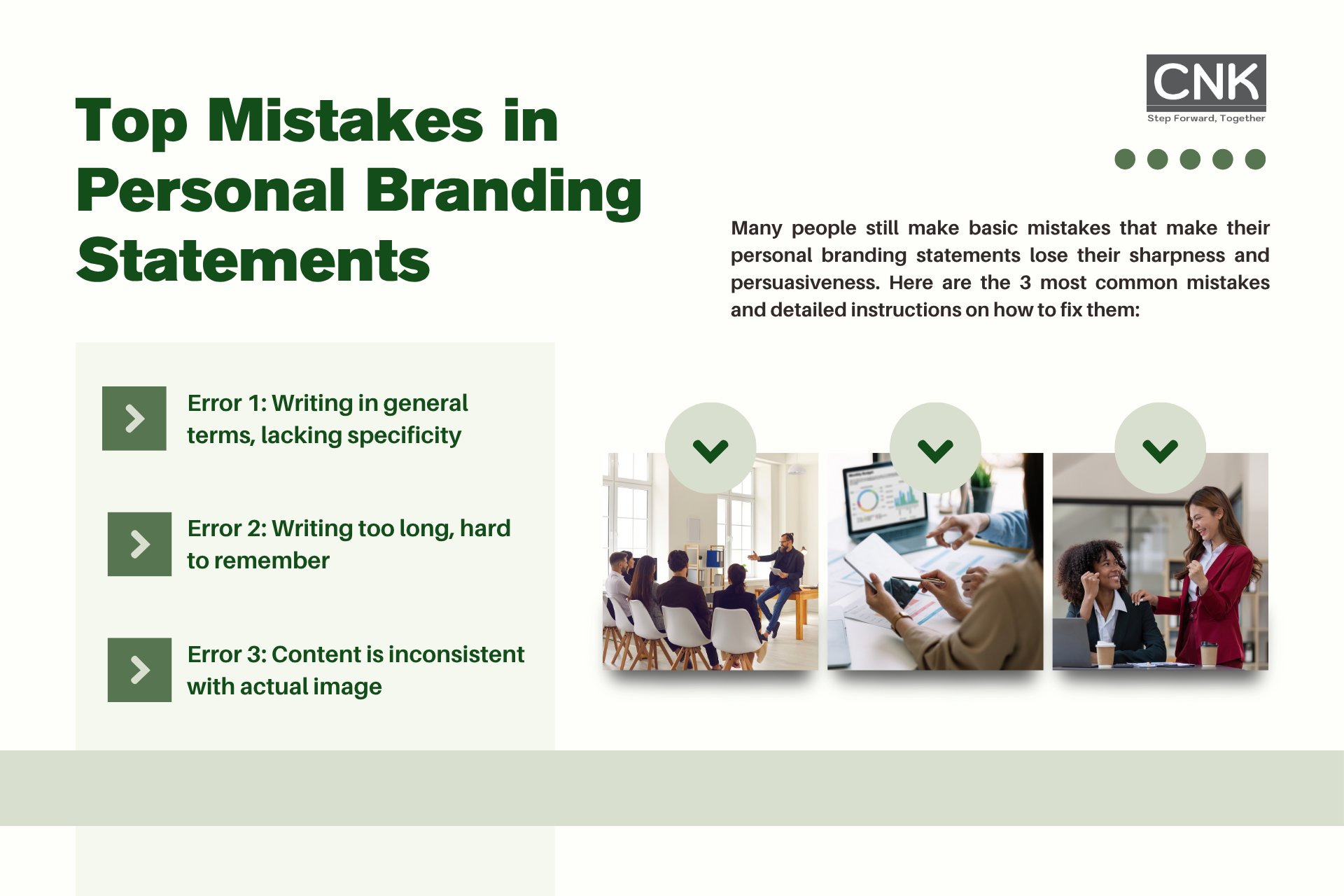
Error 1: Writing in general terms, lacking specificity
The most common mistake is to write a statement that is too general and lacks specificity. People often use clichés or job descriptions that anyone can do. This makes you look dull in the eyes of partners, employers or customers.
Solution: Always answer the question “How”. Instead of writing “I help businesses succeed”, say “I help businesses grow 40% in revenue by optimizing their multi-channel sales strategy”.
Error 2: Writing too long, hard to remember
The main purpose of a brand statement is to make a quick impression on the reader. A long statement filled with unnecessary jargon will distract the listener and cause them to forget it quickly.
Solutions:
- Length limit: Ideally 2-3 short sentences (About 70-100 words).
- Use strong verbs like Convert, Boost, Optimize,… to make your sentences more concise and powerful.
Error 3: Content is inconsistent with actual image
Your personal brand statement is not a wish, it is a promise based on your actual capabilities and character. Inconsistencies between your statement and your actions, or between your LinkedIn statement and your social media profile, will seriously undermine your credibility.
Solutions:
- Live Your Statement: Make your statement a guiding principle for your professional interactions and actions.
- Check Your Personal Brand: Periodically review all your online profiles (LinkedIn, Blog, Facebook) to ensure they support your brand statement.
Conclude
A personal branding statement is not just a self-introduction. It is a strategic declaration that reflects who you are, what your core value is, and why others should choose you. When crafted effectively, this statement becomes a solid foundation for shaping a professional image, increasing visibility, and creating a distinctive impression in every interaction, whether with partners, clients, or through content shared on social media platforms.
However, creating a clear, compelling and distinctive statement is not always easy, especially when you are struggling with too many goals, objectives and messages. That is why the personal branding service at CNK Consulting Vietnam was born to accompany you in the process of discovering your personal identity, positioning your core values and building a professional, calibrated message. Start with a clear statement and let CNK Consulting Vietnam help you turn it into a strategic, in-depth and truly influential personal brand.
CNK Consulting Vietnam
Hotline: +84 961 393 798
Email: info@cnk-consulting.com.vn
Address: 9 No. 07 New urban area Bac Dai Kim Expansion, Dinh Cong, Hoang Mai, Hanoi


